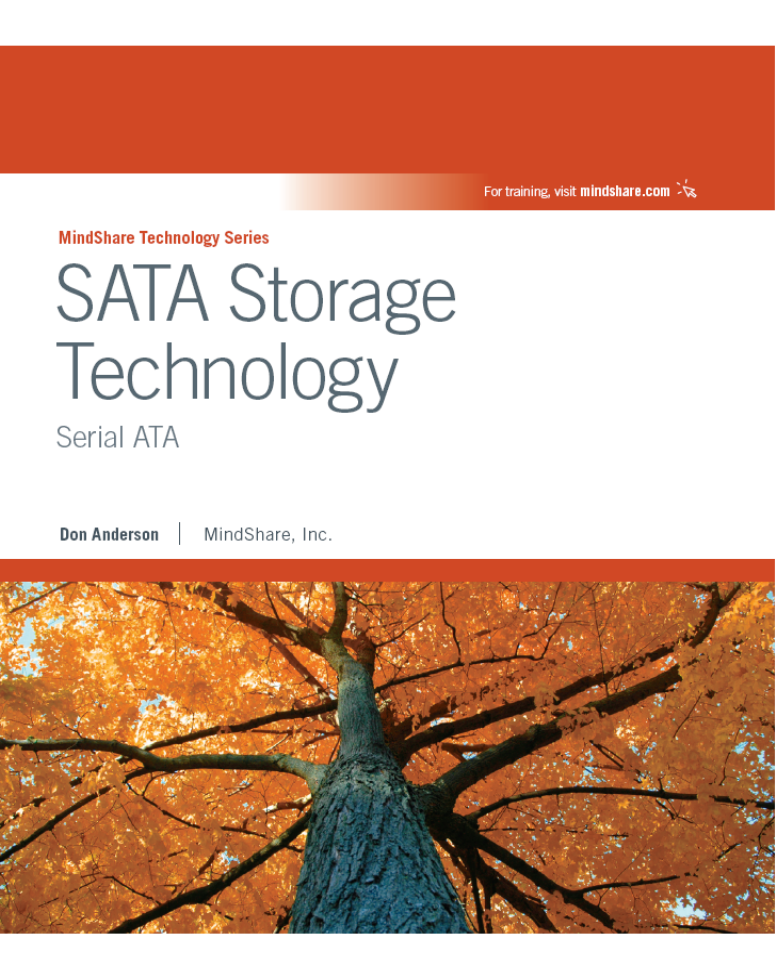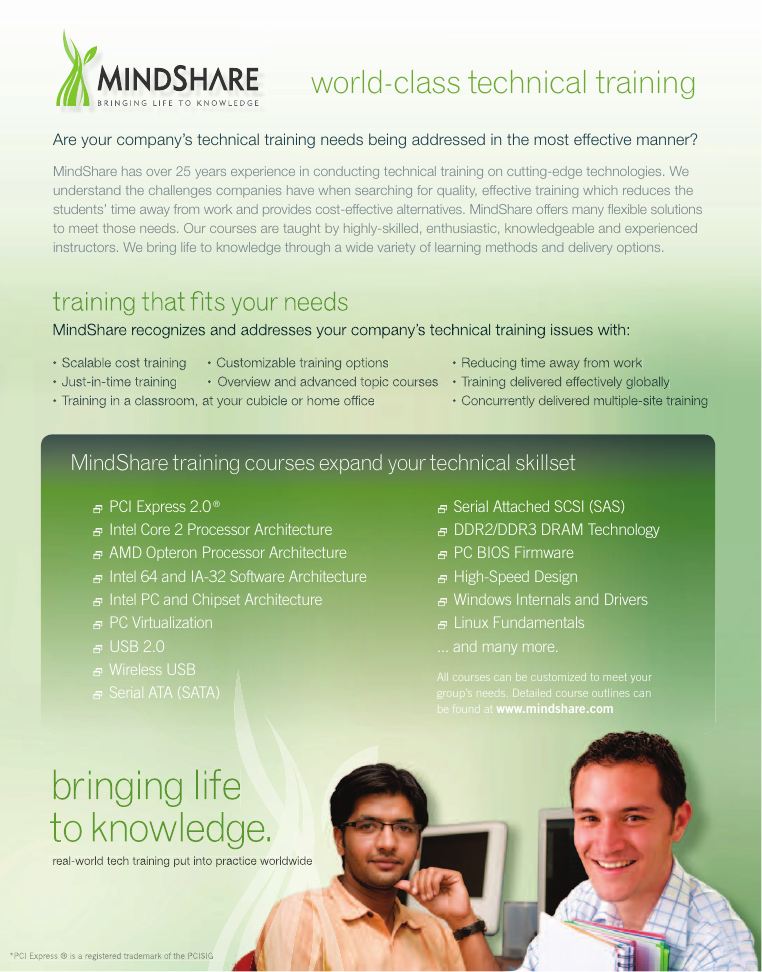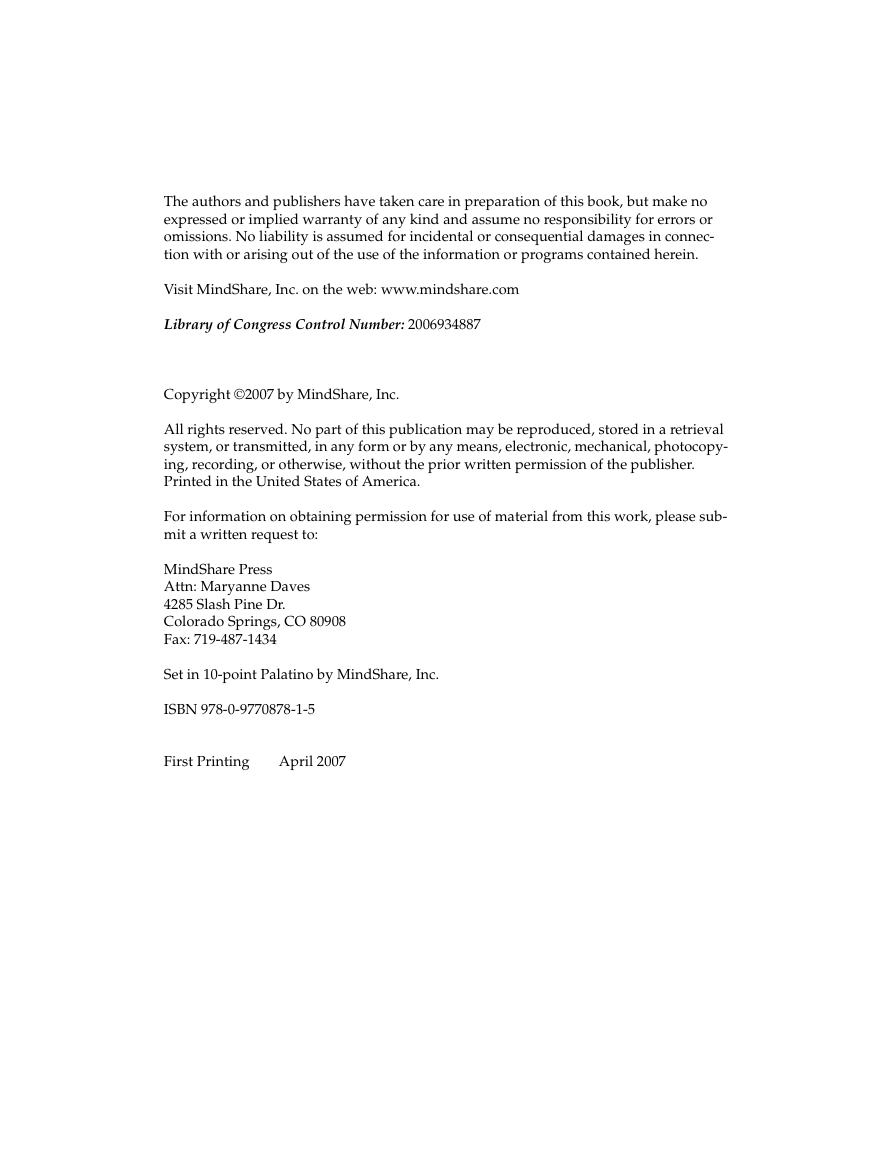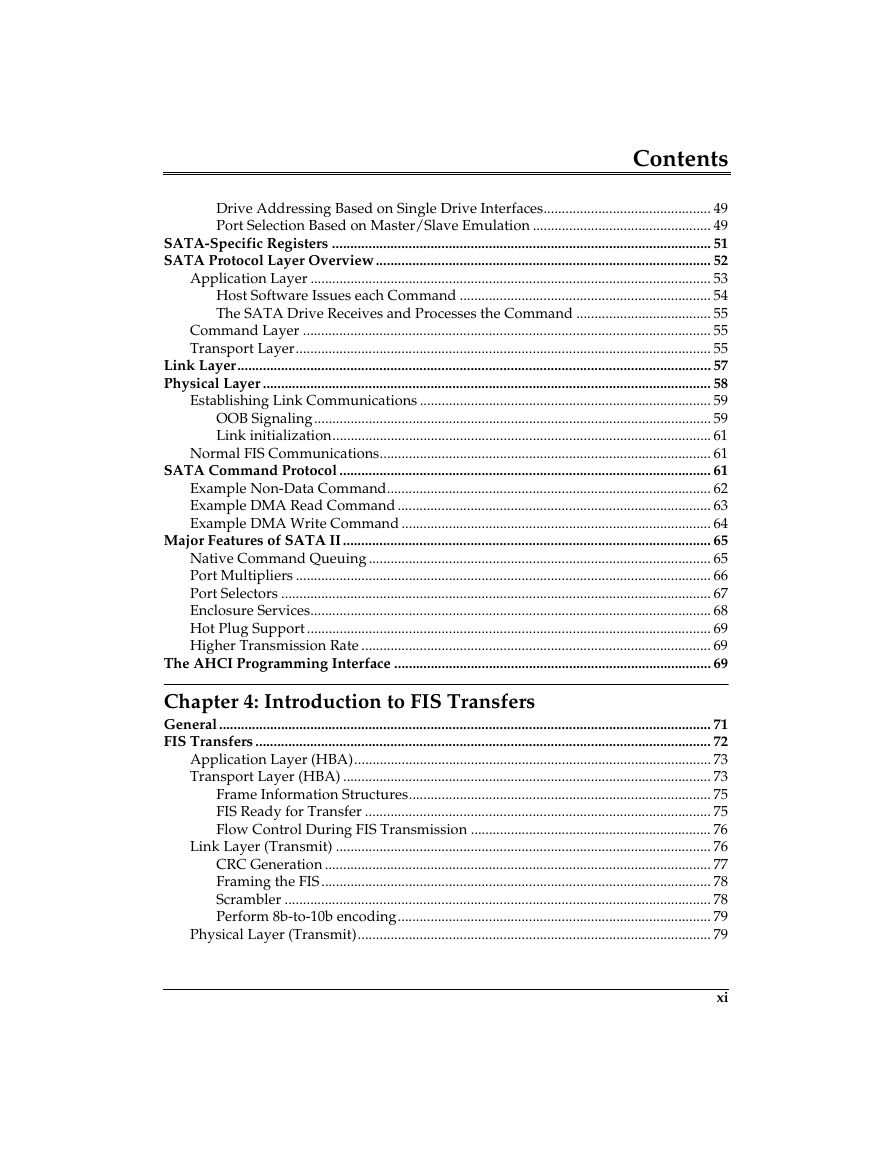�
world-class technical training
Are your company’s technical training needs being addressed in the most effective manner?
MindShare has over 25 years experience in conducting technical training on cutting-edge technologies. We
understand the challenges companies have when searching for quality, effective training which reduces the
students’ time away from work and provides cost-effective alternatives. MindShare offers many fl exible solutions
to meet those needs. Our courses are taught by highly-skilled, enthusiastic, knowledgeable and experienced
instructors. We bring life to knowledge through a wide variety of learning methods and delivery options.
training that fi ts your needs
MindShare recognizes and addresses your company’s technical training issues with:
• Scalable cost training
• Just-in-time training
• Training in a classroom, at your cubicle or home offi ce
• Customizable training options
• Overview and advanced topic courses
• Reducing time away from work
• Training delivered effectively globally
• Concurrently delivered multiple-site training
MindShare training courses expand your technical skillset
2 PCI Express 2.0 ®
2 Intel Core 2 Processor Architecture
2 AMD Opteron Processor Architecture
2 Intel 64 and IA-32 Software Architecture
2 Intel PC and Chipset Architecture
2 PC Virtualization
2 USB 2.0
2 Wireless USB
2 Serial ATA (SATA)
2 Serial Attached SCSI (SAS)
2 DDR2/DDR3 DRAM Technology
2 PC BIOS Firmware
2 High-Speed Design
2 Windows Internals and Drivers
2 Linux Fundamentals
... and many more.
All courses can be customized to meet your
group’s needs. Detailed course outlines can
be found at www.mindshare.com
bringing life
to knowledge.
real-world tech training put into practice worldwide
real-world tech training put into practice worldwide
real-world tech training put into practice worldwide
real-world tech training put into practice worldwide
*PCI Express ® is a registered trademark of the PCISIG
*PCI Express ® is a registered trademark of the PCISIG
MindShare Learning Options
MindShare
Classroom
MindShare
Virtual Classroom
MindShare
eLearning
MindShare
Press
In-House Training
Virtual In-House Training
Public Training
Virtual Public Training
Intro eLearning
Modules
Comprehensive
eLearning Modules
Books
eBooks
Classroom Training
Invite MindShare to train
you in-house, or sign-up to
attend one of our many public
classes held throughout the
year and around the world.
No more boring classes, the
‘MindShare Experience‘ is
sure to keep you engaged.
Virtual Classroom Training
The majority of our courses
live over the web in an inter-
active environment with WebEx
and a phone bridge. We deliver
training cost-effectively across
multiple sites and time zones.
Imagine being trained in your
cubicle or home offi ce and
avoiding the hassle of travel.
Contact us to attend one of
our public virtual classes.
MindShare Press
Purchase our books and
eBooks or publish your
own content through us.
MindShare has authored
over 25 books and the list
is growing. Let us help
make your book project
a successful one.
eLearning Module Training
MindShare is also an eLearning
company. Our growing list of
interactive eLearning modules
include:
• Intro to Virtualization
Technology
• Intro to IO Virtualization
• Intro to PCI Express 2.0
Updates
• PCI Express 2.0
• USB 2.0
• AMD Opteron Processor
Architecture
• Virtualization Technology
...and more
Engage MindShare
Have knowledge that you want to bring to life? MindShare will work with you to “Bring Your Knowledge to Life.”
Engage us to transform your knowledge and design courses that can be delivered in classroom or virtual class-
room settings, create online eLearning modules, or publish a book that you author.
We are proud to be the preferred training provider at an extensive list of clients that include:
ADAPTEC • AMD • AGILENT TECHNOLOGIES • APPLE • BROADCOM • CADENCE • CRAY • CISCO • DELL • FREESCALE
GENERAL DYNAMICS • HP • IBM • KODAK • LSI LOGIC • MOTOROLA • MICROSOFT • NASA • NATIONAL SEMICONDUCTOR
NETAPP • NOKIA • NVIDIA • PLX TECHNOLOGY • QLOGIC • SIEMENS • SUN MICROSYSTEMS SYNOPSYS • TI • UNISYS
4285 SLASH PINE DRIVE COLORADO SPRINGS, CO 80908 USA
M 1.602.617.1123 O 1.800.633.1440 ravi@mindshare.com
www.mindshare.com
�
SATA Storage
Technology
MINDSHARE, INC.
Donovan (Don) Anderson
Contributions by:
Mike Jackson
Duncan Penman
MINDSHARE PRESS
�
The authors and publishers have taken care in preparation of this book, but make no
expressed or implied warranty of any kind and assume no responsibility for errors or
omissions. No liability is assumed for incidental or consequential damages in connec-
tion with or arising out of the use of the information or programs contained herein.
Visit MindShare, Inc. on the web: www.mindshare.com
Library of Congress Control Number: 2006934887
Copyright ©2007 by MindShare, Inc.
All rights reserved. No part of this publication may be reproduced, stored in a retrieval
system, or transmitted, in any form or by any means, electronic, mechanical, photocopy-
ing, recording, or otherwise, without the prior written permission of the publisher.
Printed in the United States of America.
For information on obtaining permission for use of material from this work, please sub-
mit a written request to:
MindShare Press
Attn: Maryanne Daves
4285 Slash Pine Dr.
Colorado Springs, CO 80908
Fax: 719-487-1434
Set in 10-point Palatino by MindShare, Inc.
ISBN 978-0-9770878-1-5
First Printing April 2007
�
Contents
About This Book
Scope............................................................................................................................................. 1
The MindShare Architecture Series ....................................................................................... 1
Cautionary Note ......................................................................................................................... 3
The Standard Is the Final Word .............................................................................................. 3
Documentation Conventions................................................................................................... 3
Hexadecimal Notation ........................................................................................................ 3
Binary Notation.................................................................................................................... 4
Decimal Notation ................................................................................................................. 4
Bits Versus Bytes Notation ................................................................................................. 4
Bit Fields ................................................................................................................................ 4
Other Terminology and Abbreviations ................................................................................. 5
Visit Our Web Site (www.mindshare.com) .......................................................................... 5
We Want Your Feedback........................................................................................................... 6
Part One
SATA Overview
Chapter 1: The Evolution of Parallel ATA
ATA transitions to Serial Interface......................................................................................... 9
Origins of ATA ......................................................................................................................... 10
Emergence of IDE (Integrated Disc Electronics) Drives................................................... 11
Support for Two Drives .................................................................................................... 11
Compatibility Problems .................................................................................................... 12
The ATA Standard ................................................................................................................... 12
The ATA Signalling Interface........................................................................................... 13
ATA Protocol/Performance Review............................................................................... 17
ATA............................................................................................................................... 17
ATA-2/3....................................................................................................................... 17
ATA-4 ........................................................................................................................... 18
ATA-5 ........................................................................................................................... 18
ATA-6 ........................................................................................................................... 18
ATA-7 ........................................................................................................................... 18
The Legacy Programming Interface...................................................................................... 19
HBA Register Descriptions............................................................................................... 20
Device Register - Selecting the Target ATA Device............................................... 21
Start Sector Address ................................................................................................... 21
Physical Disc Address Registers........................................................................ 22
Logical Block Addressing................................................................................... 24
Logical Block Address Registers (28 bits) ........................................................ 24
ix
�
Contents
Logical Block Address Registers (48 bits) ........................................................ 24
Transfer Size Register................................................................................................. 25
Feature Register .......................................................................................................... 25
Command Register..................................................................................................... 26
Data Register ............................................................................................................... 26
Status Register ............................................................................................................. 26
Error Register .............................................................................................................. 28
Device Control Register ............................................................................................. 28
Alternate Status Register ........................................................................................... 29
Support for Multiple ATA Interfaces.............................................................................. 29
The ATA Packet Interface (ATAPI)...................................................................................... 30
Device Signature ...................................................................................................................... 31
Performing Commands........................................................................................................... 31
Setting Up Data Transfers ......................................................................................... 32
Commands without Data Transfer ................................................................... 32
Data Transfer Commands. ................................................................................. 32
Command Execution.................................................................................................. 32
Overlap and Command Queuing.................................................................................... 34
Overlap......................................................................................................................... 34
Queuing........................................................................................................................ 35
Drives Capabilities - The Device Identify Command................................................... 35
Summary of ATA Standards.................................................................................................. 36
Chapter 2: The Motivation for SATA
Motivation and Design Goals for SATA............................................................................. 37
Lower Pin Count....................................................................................................................... 38
Performance............................................................................................................................... 38
No Drive Configuration Required........................................................................................ 39
Cables and Connectors............................................................................................................ 39
Reliability .................................................................................................................................. 41
Lower Voltages ......................................................................................................................... 41
Migration to Servers ................................................................................................................ 41
Software Compatibility with Parallel ATA ........................................................................ 42
Chapter 3: SATA Overview
The SATA Specification ......................................................................................................... 43
Summary of SATA Features .................................................................................................. 44
The Serial Interconnect ........................................................................................................... 45
SATA Compatibility with Parallel ATA ............................................................................. 46
The Legacy Programming Interface................................................................................ 46
Legacy Drive Addressing with SATA ............................................................................ 48
x
�
Contents
Drive Addressing Based on Single Drive Interfaces.............................................. 49
Port Selection Based on Master/Slave Emulation ................................................. 49
SATA-Specific Registers ........................................................................................................ 51
SATA Protocol Layer Overview ............................................................................................ 52
Application Layer .............................................................................................................. 53
Host Software Issues each Command ..................................................................... 54
The SATA Drive Receives and Processes the Command ..................................... 55
Command Layer ................................................................................................................ 55
Transport Layer.................................................................................................................. 55
Link Layer.................................................................................................................................. 57
Physical Layer ........................................................................................................................... 58
Establishing Link Communications ................................................................................ 59
OOB Signaling............................................................................................................. 59
Link initialization........................................................................................................ 61
Normal FIS Communications........................................................................................... 61
SATA Command Protocol ...................................................................................................... 61
Example Non-Data Command......................................................................................... 62
Example DMA Read Command ...................................................................................... 63
Example DMA Write Command ..................................................................................... 64
Major Features of SATA II ..................................................................................................... 65
Native Command Queuing .............................................................................................. 65
Port Multipliers .................................................................................................................. 66
Port Selectors ...................................................................................................................... 67
Enclosure Services.............................................................................................................. 68
Hot Plug Support ............................................................................................................... 69
Higher Transmission Rate ................................................................................................ 69
The AHCI Programming Interface ....................................................................................... 69
Chapter 4: Introduction to FIS Transfers
General ....................................................................................................................................... 71
FIS Transfers ............................................................................................................................. 72
Application Layer (HBA).................................................................................................. 73
Transport Layer (HBA) ..................................................................................................... 73
Frame Information Structures................................................................................... 75
FIS Ready for Transfer ............................................................................................... 75
Flow Control During FIS Transmission .................................................................. 76
Link Layer (Transmit) ....................................................................................................... 76
CRC Generation .......................................................................................................... 77
Framing the FIS ........................................................................................................... 78
Scrambler ..................................................................................................................... 78
Perform 8b-to-10b encoding...................................................................................... 79
Physical Layer (Transmit)................................................................................................. 79
xi
�
















 2023年江西萍乡中考道德与法治真题及答案.doc
2023年江西萍乡中考道德与法治真题及答案.doc 2012年重庆南川中考生物真题及答案.doc
2012年重庆南川中考生物真题及答案.doc 2013年江西师范大学地理学综合及文艺理论基础考研真题.doc
2013年江西师范大学地理学综合及文艺理论基础考研真题.doc 2020年四川甘孜小升初语文真题及答案I卷.doc
2020年四川甘孜小升初语文真题及答案I卷.doc 2020年注册岩土工程师专业基础考试真题及答案.doc
2020年注册岩土工程师专业基础考试真题及答案.doc 2023-2024学年福建省厦门市九年级上学期数学月考试题及答案.doc
2023-2024学年福建省厦门市九年级上学期数学月考试题及答案.doc 2021-2022学年辽宁省沈阳市大东区九年级上学期语文期末试题及答案.doc
2021-2022学年辽宁省沈阳市大东区九年级上学期语文期末试题及答案.doc 2022-2023学年北京东城区初三第一学期物理期末试卷及答案.doc
2022-2023学年北京东城区初三第一学期物理期末试卷及答案.doc 2018上半年江西教师资格初中地理学科知识与教学能力真题及答案.doc
2018上半年江西教师资格初中地理学科知识与教学能力真题及答案.doc 2012年河北国家公务员申论考试真题及答案-省级.doc
2012年河北国家公务员申论考试真题及答案-省级.doc 2020-2021学年江苏省扬州市江都区邵樊片九年级上学期数学第一次质量检测试题及答案.doc
2020-2021学年江苏省扬州市江都区邵樊片九年级上学期数学第一次质量检测试题及答案.doc 2022下半年黑龙江教师资格证中学综合素质真题及答案.doc
2022下半年黑龙江教师资格证中学综合素质真题及答案.doc